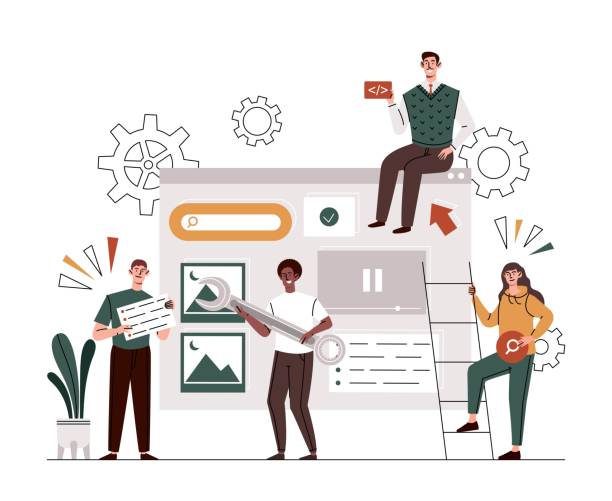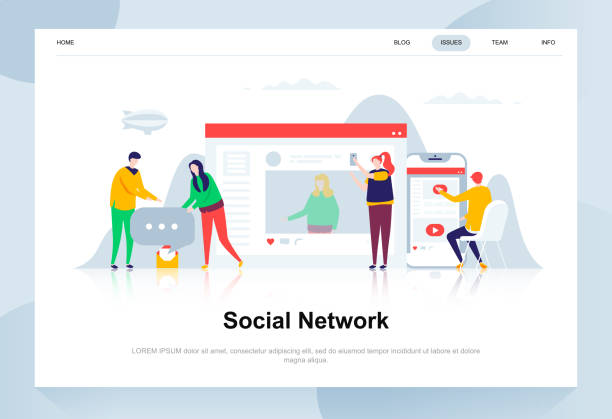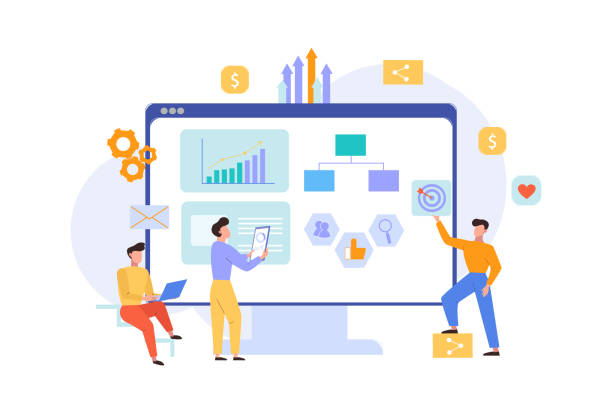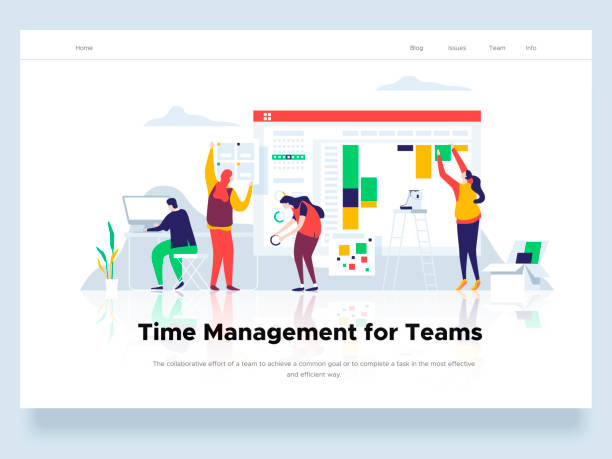An Introduction to the Importance of E-commerce Website Design in Today’s World

In the current digital age, a strong online presence is critically important for any business, especially for retail activities. #Online_Store is no longer a luxury option, but a necessity for #competition and survival in the market.
With the increasing number of internet users and the shift in shopping habits from physical stores to online platforms, an efficient and attractive e-commerce website design is considered a gateway to infinite opportunities for your business development.
This process is not limited to just launching a website; it includes a deep understanding of customer needs, providing a smooth user experience, and implementing digital marketing strategies.
Without an online store, your business will not be able to reach a large segment of the target market, and as a result, its growth and profitability potential will be limited.
Today, consumers expect to be able to easily purchase the products and services they need anytime, anywhere.
This expectation doubles the need for a professional e-commerce website design that not only showcases products but also provides a secure, fast, and enjoyable online shopping experience.
This section of the article descriptively and analytically examines the reasons why having an e-commerce website is no longer a competitive advantage, but a fundamental pillar for any modern business.
From 24/7 access to customers worldwide to reduced operational costs and the ability to collect valuable customer data for service improvement, there are countless benefits to successful e-commerce website design.
This platform allows you to present your products attractively, provide easy comparison and selection options for customers, and facilitate the purchase process through secure payment gateways.
Additionally, with available analytical tools, you can monitor customer behavior and optimize your sales strategies based on real data.
This is a smart investment for the future of your business, with a long-term return far exceeding initial costs.
Furthermore, a precise understanding of market trends and technological changes in the e-commerce sector is crucial for success in e-commerce website design.
Mobile platforms, artificial intelligence, and augmented reality are just some of the technologies reshaping the online shopping experience.
A modern e-commerce site must be able to keep pace with these developments and have the necessary flexibility to embrace new innovations.
This section will also provide an analytical look at the challenges ahead and hidden opportunities in the online market.
For example, challenges such as increasing competition, the need to attract targeted traffic, and complex logistics management must all be considered in the e-commerce website design strategy.
On the other hand, opportunities such as accessing new markets, reducing marketing costs through digital methods, and establishing direct and sustainable relationships with customers provide enormous potential for businesses.
Therefore, entering the world of e-commerce with a professional website is not only a preventive measure but also a strategic step to ensure a bright future for your business.
Does your company’s website perform as befits your brand? In today’s competitive world, your website is your most important online tool. Rasaweb, specializing in professional corporate website design, helps you to:
✅ Gain customer credibility and trust
✅ Convert website visitors into customers
⚡ Get a free consultation!
Strategic Planning Before Starting E-commerce Website Design

Before you pick up a pen and start coding or choosing a template, the strategic planning phase for e-commerce website design is of paramount importance.
#Online_Store_Planning will guarantee your long-term success.
This educational and guiding stage includes defining precise goals, identifying target audiences, competitor analysis, and budget determination.
Your goals must be Specific, Measurable, Achievable, Relevant, and Time-bound (SMART).
For example, is your goal to increase sales, expand the brand, or provide better services to existing customers? Answers to these questions will define the direction of your site’s design and development.
Without a clear roadmap, the probability of wasting resources and time is very high.
A deep understanding of the target audience is the foundation of any successful e-commerce website design.
You need to know who your customers are, what their needs are, how they behave, and what devices they use for online shopping.
This information helps you optimize the design, content, and user experience of your site to be most appealing to them.
For example, if your audience primarily shops via mobile, a Responsive Design is crucial for your site.
Furthermore, competitor analysis allows you to identify their strengths and weaknesses and highlight your competitive advantages.
What distinguishes you from competitors? Price, product quality, customer service, or a unique shopping experience? These distinctions must be reflected in all aspects of your e-commerce website design.
Budgeting is another vital aspect of the planning stage.
The cost of creating an online store can vary greatly, depending on the site’s complexity, required features, and chosen platform.
You need to have a realistic estimate of initial costs (including design, development, hosting, domain) and ongoing costs (including maintenance, marketing, support).
This financial forecast helps you avoid financial problems during the project.
Additionally, setting a timeline for each stage of e-commerce website design, from conceptualization to launch, ensures that the project stays on track.
Remember that meticulous planning, though seemingly time-consuming, ultimately leads to savings in time and cost and achieving better results.
This stage forms the foundation of your entire project, and neglecting it can lead to serious failures in the future; therefore, view strategic planning as the cornerstone of success.
Choosing the Right Platform for Your E-commerce Website Design

One of the most important decisions in the e-commerce website design process is choosing the right platform.
#Suitable_E-commerce_Platform will determine many of your future features, capabilities, and even costs.
This section specifically and descriptively compares common platforms to help you choose the best option for your business.
There are two main categories of platforms: SaaS (Software as a Service) platforms like Shopify and BigCommerce, and Open-Source platforms like WooCommerce (based on WordPress) and Magento.
Each of these options has its specific advantages and disadvantages that must be weighed against your needs and budget.
SaaS platforms are ideal for small and medium-sized businesses looking for a quick and hassle-free launch.
They typically include hosting, support, and security updates and do not require extensive technical knowledge.
Shopify is one of the most popular options due to its simple user interface, strong built-in marketing tools, and a vast ecosystem of apps and themes.
However, you have less control over the code and customization capabilities, and you must pay a monthly subscription fee.
In contrast, open-source platforms like WooCommerce, an extension for WordPress, offer complete control and unparalleled flexibility.
You can customize every aspect of the site, but you are responsible for hosting, security, and maintenance, which requires more technical knowledge.
Magento is also suitable for large and complex businesses with specific needs and high budgets, but its development complexity and costs are significantly higher.
To aid in better decision-making, the following table provides a comparison between some of the most popular platforms in e-commerce website design:
| Feature | Shopify | WooCommerce | Magento |
|---|---|---|---|
| Ease of Use | Very High | Medium | Low |
| Flexibility and Customization | Medium (Limited to Apps) | Very High (Open-Source) | Very High (Complex) |
| Initial Cost | Low (Monthly Subscription) | Medium (Hosting, Development) | High (Professional Development) |
| Required Technical Knowledge | Low | Medium | Very High |
| Scalability | Good | Very Good | Excellent |
The final choice should be based on your budget, business size, existing technical knowledge, and long-term plans.
Each platform offers a set of tools and capabilities that can help you build a successful online store.
The most important thing is to choose a platform that can meet your current needs and also have the ability to expand and grow in the future.
A successful e-commerce website design begins with the correct infrastructure choice, and without this precise choice, you may encounter unexpected challenges.
User Interface (UI) and User Experience (UX) Design in E-commerce Websites

After choosing the right platform, it’s time for one of the most critical stages in building an online store: User Interface (UI) and User Experience (UX) design.
#UI_UX_Online_Store directly impacts customer satisfaction and, ultimately, the Conversion Rate.
This section, specifically and instructively, addresses the importance of attractive visual design and easy navigation for users.
An e-commerce website should not only be beautiful but also designed so that users can easily find their desired products, obtain sufficient information about them, and complete the purchase process without any issues.
In fact, a poor user experience can deter buyers from even the best products.
User Interface (UI) refers to the visual aspects of the site, such as colors, fonts, element layout, buttons, and images.
An attractive and professional UI creates the first positive impression in the customer’s mind and instills a sense of trust.
Using high-quality images, clear and concise product descriptions, and designing distinct and visible Call-to-Action buttons are among the basic principles of successful UI design.
In contrast, User Experience (UX) relates to the user’s overall feeling when using your site.
Does the site load quickly? Is navigation logical and easy? Is the payment process not complicated? A good UX encourages users to spend more time on your site and become loyal customers.
Page loading speed, responsiveness across different devices (mobile, tablet, desktop), and robust search capabilities are key factors in improving UX.
Easy access to support, diverse shipping options, and the ability to track orders are also of high importance.
To ensure excellent UI/UX in creating an online store, you must adhere to the principles of User-Centered Design.
This means placing the user at the center of the design process.
Conducting user research, creating personas, and A/B tests can help you better understand user needs and behaviors.
Additionally, providing features such as advanced product filters, product comparisons, and customer reviews improves the shopping experience for users.
For example, a simple, multi-step payment process can significantly reduce shopping cart abandonment rates.
Remember that the better the user experience, the higher the likelihood of returning customers and increased sales.
Ultimately, focusing on details and continuous improvement based on user feedback will help you build a truly successful online store that customers love and trust, thereby contributing significantly to your business’s sustainable growth.
Research shows that 80% of customers trust companies with a professional website more. Does your current site inspire this trust?
With Rasaweb’s corporate website design services, permanently solve the problem of lack of customer trust and a weak online image!
✅ Create a professional image and increase customer trust
✅ Attract more sales leads and grow your business
⚡ Get a free consultation
Search Engine Optimization (SEO) in E-commerce Websites

After your e-commerce website creation is complete, one of the most important steps to attract new customers is optimizing it for search engines (SEO).
#Online_Store_SEO means that your site will rank higher in Google or other search engine results for keywords related to your products.
This section instructively and expertly shows you how to direct more organic (free) traffic to your online store by adhering to SEO principles.
Without SEO, even the most beautiful and user-friendly e-commerce website may go unnoticed among a multitude of competitors, and your business’s potential may not be realized.
The principles of SEO for e-commerce sites include several important factors.
The first step is keyword research.
You need to identify the words your potential customers use to find your products.
These keywords should be naturally integrated into product titles, descriptions, meta descriptions, and category page content.
Additionally, optimizing product images for size and using appropriate Alt tags is essential for SEO and site speed.
Site loading speed is also a crucial factor; slow sites provide a poor user experience and encounter problems in Google rankings.
Using strong hosting, image compression, and code optimization can help increase site speed.
Clean and understandable URL structures, the use of structured data (Schema Markup) to display richer information in search results, and efficient internal navigation all contribute to improving technical SEO.
In addition to technical and On-Page SEO (internal site factors), Off-Page SEO (external site factors) also plays a significant role in the success of your online store.
This includes building quality links from other websites (link building), active presence on social media, and creating engaging and shareable content.
For example, writing blog articles related to your products or industry not only helps attract traffic through longer keywords but also establishes you as an authoritative source in your field.
Monitoring site performance through tools like Google Analytics and Google Search Console is also essential for identifying SEO issues and improvement opportunities.
These analyses help you continuously adjust and optimize your SEO strategy.
Remember that SEO is an ongoing process, and its results appear gradually.
By correctly implementing these principles in launching your online store, you can ensure that your business will be seen in the competitive online world and achieve sustainable success.
Security and Data Protection in E-commerce Websites

In the high-risk world of the internet, security and data protection are among the most crucial considerations in #creating_an_e-commerce_website and managing it.
#Online_Store_Security not only builds customer trust but also protects your business from cyberattacks and the loss of valuable information.
This section specifically and informatively addresses the importance of implementing strong security protocols and adhering to user privacy.
Any security weakness can lead to credit card information theft, personal data breaches, and the erosion of your brand’s reputation, which would be very difficult to recover and could also have serious legal consequences.
The first step in ensuring the security of an e-commerce site is to use an SSL (Secure Sockets Layer) certificate.
SSL creates a security layer that encrypts information exchanged between the user and the website server.
This is essential for protecting sensitive information such as credit card details and customer personal information, and it is indicated by a green padlock icon in the browser’s address bar.
In addition to SSL, you must use a secure and reliable hosting platform that features strong firewalls, intrusion detection systems, and regular data backups.
Regular updates of the Content Management System (CMS), plugins, and themes used on the site are also highly important, as older versions may have security vulnerabilities that hackers can exploit.
Implementing Two-Factor Authentication for the site’s admin panel and users, and using complex passwords, are also among the essential security measures.
Strong policies regarding data privacy must also be implemented in your online store design and development.
This includes transparency about how customer information is collected, stored, and used.
Adherence to privacy regulations such as GDPR (General Data Protection Regulation) in Europe or similar laws in other regions is essential.
Furthermore, you must implement secure payment methods on your site.
Using reputable and recognized payment gateways that adhere to PCI DSS (Payment Card Industry Data Security Standard) security standards greatly helps protect customers’ financial information.
Educating staff on cybersecurity best practices and creating strong passwords can also prevent many internal threats.
Remember that security is an ongoing process and requires continuous monitoring and improvement.
By focusing on this crucial aspect in creating an e-commerce website, you can ensure that your business and customers are protected against cyber threats and that your credibility in the market increases.
Essential Features and Practical Plugins for E-commerce Websites

For your e-commerce website to function flawlessly and efficiently, it must be equipped with essential features and practical plugins.
#Online_Store_Features These vital elements improve the customer shopping experience and facilitate your business operations.
This section descriptively and instructively introduces the capabilities every online store needs for success.
The correct selection and implementation of these features can make a significant difference in conversion rates and customer satisfaction and help you stand out in the competitive market.
Some essential features that every successful online store should have include:
- User-friendly shopping cart: The process of adding products to the cart and editing it should be simple and clear, with the ability to easily view the order summary.
- Easy and secure payment process: Including diverse and reliable payment gateways, and the option to checkout as a guest without mandatory registration.
- Product pages with complete details: High-quality images, product videos, precise and compelling descriptions, technical specifications, and customer reviews and ratings.
- Advanced search and filtering capabilities: To help users quickly find products based on various characteristics (color, size, price, etc.).
- Responsive Design: Ensuring correct display and optimal user experience on all devices (mobile, tablet, desktop).
- Inventory management system: An automated system for updating inventory and preventing the sale of out-of-stock products, along with the ability to warn of low stock.
- Order management system: For efficient tracking and management of orders from placement to delivery, and the ability to send automatic notifications to the customer.
In addition to these basic features, advanced plugins and capabilities can enrich the shopping experience.
The table below lists some practical plugins for building an e-commerce website:
| Plugin/Feature Type | Goal | Example/Application |
|---|---|---|
| Online Chat and Support | Increase customer satisfaction, instant response, and reduce abandoned cart rate | Answer questions, solve problems, 24/7 support, provide assistance during purchase |
| Reviews and Rating System | Increase trust, SEO, create User-Generated Content (UGC) | Show real customer experiences, product ratings, encourage purchases |
| Smart Product Recommendations | Increase Average Order Value (AOV) and conversion rate | “Related Products”, “Customers who bought this also bought”, “Personalized recommendations” |
| Email Marketing Tools | Customer retention, sending newsletters and discounts, building loyalty | Abandoned cart reminders, email campaigns for special events |
| Traffic and User Behavior Analytics | Understand site performance, optimize user experience and sales strategies | Google Analytics, Hotjar for heatmaps and user session recordings |
The selection and implementation of these features and plugins should be based on your business type, products, and target audience.
The ultimate goal is to provide a seamless and enjoyable shopping experience for customers while optimizing your store operations.
By investing appropriately in this section, your e-commerce website will become a powerful tool for growth and success, solidifying your position in the online market.
Marketing and Customer Acquisition Strategies After Launching an Online Store

Creating an e-commerce website alone does not guarantee success.
After launch, the most important step is to implement targeted marketing strategies to attract customers and increase sales.
#Online_Store_Marketing involves a series of activities that help your site gain visibility and convert visitors into buyers.
This section analytically and instructively examines effective methods for promoting and developing your online store.
Without a strong marketing plan, even the best online store might get lost among numerous competitors, and your investment may not yield the desired return.
One of the most powerful tools is content marketing.
By creating valuable content related to your products, such as blog articles, guides, videos, and infographics, you can attract organic traffic through search engines and establish yourself as an expert in your field.
This type of content not only helps improve SEO but also provides useful information to potential customers, assisting them in the decision-making process.
Using social media is also very effective for customer acquisition and engagement.
Choosing appropriate social platforms based on your target audience, and publishing engaging content with a Call to Action, can help increase brand awareness and drive traffic to your e-commerce site.
Paid advertising, such as Google Ads and social media ads (like Facebook and Instagram Ads), is a quick way to attract targeted traffic, although it requires a specific budget.
Precise targeting of ads based on age, gender, interests, and online user behavior significantly increases their effectiveness.
Email marketing is still one of the most effective methods for maintaining customer relationships and increasing sales.
Collecting customer emails (with their permission) and sending newsletters, special offers, abandoned cart reminders, and new product announcements can significantly increase conversion rates.
Collaborating with influencers and Affiliate Marketing can also help you reach new audiences.
Offering discounts, promo codes, and customer loyalty programs are proven methods to encourage purchases and increase customer loyalty.
Holding engaging online contests and campaigns can also increase user participation and make your brand memorable in their minds.
Whichever marketing strategy you choose, it must be regularly monitored and analyzed so you can evaluate its performance and make necessary changes if needed.
Success in e-commerce after creating an e-commerce website depends on your ability to attract and retain customers, and this is only achieved with a comprehensive and dynamic marketing strategy.
Dissatisfied with the low conversion rate of visitors to customers on your e-commerce site?
With professional e-commerce website design by Rasaweb, solve this problem forever!
✅ Increase visitor-to-customer conversion rate
✅ Create an excellent user experience and gain customer trust
⚡ Get a free consultation
Continuous Support and Maintenance for Your Online Store

After launch and marketing, another important stage often overlooked is the continuous support and maintenance of your online store.
#Online_Store_Support This vital process guarantees the smooth and uninterrupted operation of your site in the long term and descriptively and instructively addresses the importance of this topic.
An e-commerce site that is not properly maintained may encounter security issues, slow speeds, or errors, all of which damage the user experience and lead to lost sales.
This can also severely harm your brand’s reputation and credibility.
Technical site maintenance includes regular software updates (Content Management System, themes, plugins), checking for broken links, database optimization, and server performance monitoring.
These actions prevent many problems and help improve site speed and security.
Regular backups of all site data (files and database) are also crucial so that in the event of any serious issue, such as cyberattacks or system errors, you can quickly restore the site and prevent data loss.
Additionally, reviewing and fixing potential bugs and errors helps improve site stability.
Monitoring server performance to prevent downtime and ensure fast site response time is also very important, as even a few seconds delay in loading can lead to customer loss.
In addition to technical maintenance, excellent customer support is also an inseparable part of a e-commerce website’s success.
Providing multiple communication channels such as online chat, phone, email, and a ticketing system allows customers to easily ask questions or report problems.
Prompt and effective responses to customer inquiries and complaints lead to increased satisfaction and loyalty.
Furthermore, a Frequently Asked Questions (FAQ) section and user guides can answer many common questions and reduce the workload of the support team.
Analyzing customer feedback can also provide valuable information for improving your products and services.
Remember that satisfied customers are the best promoters for your business.
Therefore, investing in support and maintenance is not just an expense, but an investment in the growth and sustainability of your e-commerce platform that helps you always provide an excellent shopping experience for your users and stay ahead of competitors.
The Future of E-commerce Websites and Upcoming Trends

The world of e-commerce, and consequently, the creation of e-commerce websites, is constantly evolving and progressing.
#Future_of_Online_Store For your business to remain a leader in this competitive space, you must be aware of future trends and adapt to them.
This section analytically and entertainingly looks at the innovations and technologies shaping the future of online shopping, and also includes thought-provoking content that makes you ponder.
Are you ready for the next revolution in e-commerce? How can your business leverage these developments to its advantage?
One of the most important upcoming trends is the integration of Artificial Intelligence (AI) and Machine Learning (ML) into online stores.
These technologies can highly personalize the shopping experience, from more accurate product recommendations to smart chatbots for customer support.
AI can analyze user purchasing behavior and provide unique suggestions that increase conversion probability.
Augmented Reality (AR) and Virtual Reality (VR) are also changing how customers interact with products.
Imagine being able to virtually see a sofa in your living room before buying it or trying on clothes in 3D.
These immersive experiences add new dimensions to online shopping and increase the need for e-commerce store design with advanced visual capabilities.
These technologies enable businesses to showcase their products in novel and attractive ways.
Voice shopping through smart assistants like Alexa and Google Assistant is another growing trend.
This requires optimizing product content for voice search and creating infrastructures to support this type of shopping.
Additionally, corporate sustainability and social responsibility have become important factors in buyer decision-making.
Customers are looking for brands that adhere to ethical and environmental values; therefore, highlighting these aspects on your e-commerce website can create a competitive advantage.
The question is, how can we integrate these emerging trends into our online store architecture in a way that both improves user experience and is commercially beneficial? Can we predict which of these technologies will soon become standard and which are merely fleeting excitements? The future belongs to stores that not only offer good products but also provide innovative and personalized experiences for their customers.
Preparing for this future requires flexibility, innovation, and a long-term vision in your e-commerce website project to remain competitive and progressive.
Frequently Asked Questions
| Question | Answer |
|---|---|
| What is e-commerce website design? | It is the process of creating an online platform for selling products or services, which includes User Interface (UI) design, User Experience (UX), and the necessary functionalities for online purchasing. |
| What are the key features of a good e-commerce website? | Easy navigation, high loading speed, robust search capability, efficient shopping cart, secure payment gateway, clear product display with high-quality images, ability to show user reviews, and responsiveness (mobile compatibility). |
| What platforms are common for e-commerce website design? | Popular platforms such as WooCommerce (on WordPress), Shopify, Magento, PrestaShop, and also proprietary Content Management Systems. |
| What is the importance of an e-commerce website being responsive? | Given the increasing use of mobile for online shopping, site responsiveness (correct display on different screen sizes) is crucial for providing a good user experience and increasing conversion rates. |
| How long does the process of designing an e-commerce website usually take? | The duration depends on the project’s complexity, the number of products, required special features, and the implementation method, and can vary from a few weeks to several months. |
And other advertising services from Rasa Web advertising agency:
- Smart Marketplace: A combination of creativity and technology to increase click-through rates through intelligent data analysis.
- Smart Direct Marketing: A specialized service for growing user engagement based on intelligent data analysis.
- Smart Conversion Rate Optimization: A specialized service for increasing site visits based on custom programming.
- Smart Advertising Campaign: Transform online growth with the help of Google Ads management.
- Smart Advertising Campaign: Transform customer acquisition with the help of key page optimization.
And over a hundred other services in the field of internet advertising, advertising consulting, and organizational solutions.
Internet Advertising | Advertising Strategy | Advertorials
Sources
Guide to Choosing the Best Online Store Building PlatformsKey SEO Tips for Increasing Online Store SalesThe Importance of User Experience (UX) Design in Online Store SuccessWhy Security is Crucial for E-commerce Sites?
? With Rasaweb Afarin, your business will be transformed in the digital world; from secure website design to targeted marketing, we are with you.
📍 Tehran, Mirdamad Street, next to Bank Markazi, Kazerun South Alley, Ramin Alley, No. 6
